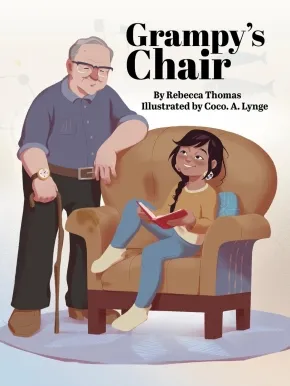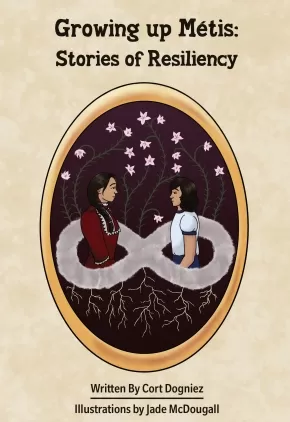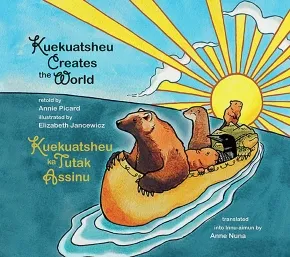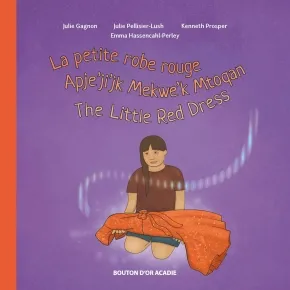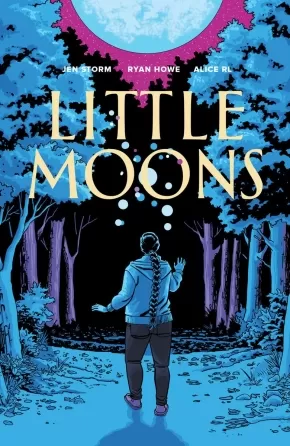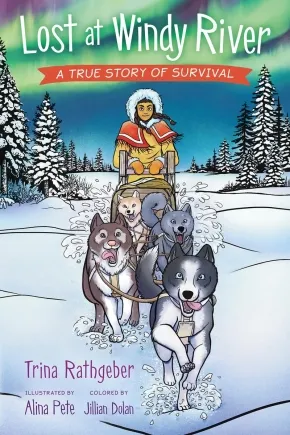
Canadian Indigenous Resource Lists
46
-
60
of
473 Results;
Sort By
Go To
of 32
Grampy's Chair
$23.99
Artists:
Format:
Hardcover
Text Content Territories:
Indigenous Canadian; First Nations; Mi'kmaq;
ISBN / Barcode: 9781773219189
Synopsis:
Synopsis:
A heartwarming story about lifelong love and loss told from the perspective of a grandfather’s favorite chair.
Grampy’s chair sits in the middle of his living room and always keeps an eye on My Love. The Chair is the perfect spot for My Love to learn to read, to play games with her friends, and The Chair is always extra soft when My Love is sick. As My Love grows up, The Chair sees Grampy grow older and My Love must care for him. One day Grampy is gone, and The Chair is moved to a space with only a few things it recognizes (and a few spiders too). Will it see My Love again?
In this poignant story inspired by her own grandfather and his chair, Rebecca Thomas invites readers of all ages to explore love, grief, and the important moments in life that take place in our favorite spots. With lively illustrations from Coco A. Lynge and featuring a heartfelt author’s note, Grampy's Chair takes the readers through loss, and how we can be found again by the ones we love.
Reviews
"Although the author is Mi’kmaw, the story does not directly reference Mi’kmaw culture. Instead, it draws on her personal experience in a mixed-heritage family and offers a heartfelt reflection on the loss of a grandparent. Thomas’s poetic voice invites readers to reflect on someone special and the emotional meaning attached to everyday objects, such as a chair, photograph, or place. Lynge’s gentle illustrations enrich the story’s emotional tone, helping readers connect with the emotions expressed in the story. Suitable for K–3 classrooms, this picture book supports curricular connections in English Language Arts and Social Studies. In ELA, it invites exploration of perspective, voice, symbolism, and story structure. In Social Studies, it can spark discussion around family diversity, intergenerational knowledge, and memory." - Bonny-Lynn D., Elementary School Teacher, Indigenous Books for Schools
Educator Information
Recommended for ages 4 to 7.
This book is included in the Indigenous Books for Schools database from the Association of Book Publishers of BC. It is recommended for K to 3 classrooms for English Language Arts and Social Studies.
Additional Information
36 pages | 7.65" x 10.25" | Hardcover
Growing up Métis : Stories of Resiliency
$17.50
Artists:
Format:
Paperback
Text Content Territories:
Indigenous Canadian; Métis;
ISBN / Barcode: 978-1-988011-34-9
Synopsis:
Synopsis:
Cort Dogniez’s Growing up Métis: Stories of Resiliency is the second installment of his historical fiction series that began with Road to La Prairie Ronde. In two separate, but connected fictionalized stories, Cort delves into the lives of two of his foremothers: his great-grandmother, Josephine Gariepy and his grandmother, Clara Dumont when they were young. While highlighting the dispossession and marginalization of his ancestors following the 1885 Resistance, Cort deftly weaves Métis culture through these two stories with a positive “focus on nicknames, faith, storytelling, and a resilient spirit.”
Jade McDougall’s beautiful illustrations brings these poignant, coming of age stories to life. Growing up Métis: Stories of Resiliency includes Michif and Cree glossaries to reflect Josephine and Clara’s first languages as well as guide questions for educators to explore the stories and Métis culture in depth with their students.
Educator & Series Information
Recommended by the publisher for ages 9+.
This book is the second installment in the historical fiction series that began with Road to La Prairie Ronde.
This book is included in the Indigenous Books for Schools database from the Association of Book Publishers of BC.
Additional Information
85 Pages | 14 cm x 20.3 cm | Paperback
Haudenosaunee: The People and Nations
$16.95
Format:
Paperback
Text Content Territories:
Indigenous Canadian; First Nations; Haudenosaunee (Iroquois);
ISBN / Barcode: 9781774565124
Synopsis:
Synopsis:
The Haudenosaunee, like many Indigenous Nations and communities across North America, have their own history and culture. Discover the Peacemaker Story, which explains how the Confederacy was created. Learn about historical facts and their effects on present times. Get to know Haudenosaunee people who give thanks everyday and have many stories and traditions to tell.
Educator & Series Information
This book is part of the Indigenous Nations in North America series.
This book is included in the Indigenous Books for Schools database from the Association of Book Publishers of BC.
Additional Information
32 Pages | Paperback
How I Survived: Four Nights on the Ice (PB)
$18.95
Artists:
Format:
Paperback
Text Content Territories:
Indigenous Canadian; Inuit;
ISBN / Barcode: 9781772274264
Synopsis:
Synopsis:
After his snowmobile breaks down halfway across the sea ice on a trip back from a fishing camp, Serapio Ittusardjuat recounts the traditional skills and knowledge he leaned on to stay alive.
This harrowing first-person account of four nights spent on the open sea ice—with few supplies and no water—shows young readers the determination and strength necessary to survive in the harsh Arctic climate, even when the worst occurs.
Awards
- 2022 Forest of Reading—Silver Birch Express Award
Reviews
"[T]he graphic novel How I Survived is a true story of Arctic survival written by Serapio Ittusardjuat, an Inuk stone carver and former mechanic.... This beautifully designed, highly engaging graphic novel should engross both reluctant readers and those seeking adventure." - Quill & Quire
Educator Information
Recommended for ages 12+
The original hardcover version was included in the Indigenous Books for Schools 2020/2021 resource list as being useful for grades 6 to 9 for English Language Arts and Social Studies.
Additional Information
48 pages | 7.25" x 9.75"
Hummingbird / Aamo-binashee
$21.95
Artists:
Format:
Hardcover
Text Content Territories:
Indigenous Canadian; First Nations; Anishinaabeg;
ISBN / Barcode: 9781459837140
Synopsis:
Synopsis:
You never walk alone.
Remember the hummingbird's teachings. Remember you are loved.
Kokum warned us to watch out for one another. If we weren't careful, Windigo would eat us. But one night, alone in the darkness, I felt its breath on my neck. Windigo's lies crept into my heart, and I believed them. When we lose connection with others, we lose ourselves, and Windigo's darkness grows and spreads.
In this deeply emotional and beautifully illustrated picture book, the ancestors send a hummingbird to a child lost in Windigo’s darkness. Its teachings of resilience, love and connection bring the child home and remind us that our ancestors are always watching and can help us find our way if we only ask.
This bilingual book includes full text in both English and Anishinaabemowin.
Educator Information
Recommended for ages 6 to 8.
Fountas & Pinnell Text Level Gradient: U
Lexile measure: 520L
Guided Reading Level: U
Dual-Language: English and Anishinaabemowin
There are many dialects fo Anishinaabemowin, and this book presents a phonetic spelling of the language as learned by the author and co-translator in Duck Bay, northeastern Manitoba. This dialect is sometimes referred to as Western Ojibwa, Nakawemowin, Saulteaux or Plains Ojibwa. Translated by Norman Chartrand and Jennifer Leason.
This beautifully illustrated story expresses hope, healing and reclamation of Indigenous strength and identity in the wake of oppression and trauma.
This book is included in the Indigenous Books for Schools database from the Association of Book Publishers of BC. It is recommended for Grades 1 to 3 for Art, English Language Arts, and Social Studies.
Additional Information
32 pages | 8.00" x 8.00" | Hardcover
It Bears Repeating
$23.99
Artists:
Format:
Hardcover
Text Content Territories:
Indigenous Canadian; Inuit;
ISBN / Barcode: 9781774880555
Synopsis:
Synopsis:
This beautifully crafted picture book celebrates one of the world's most awesome animals: the polar bear. Evocative but simple text by award-winning musician and artist Tanya Tagaq is accompanied by striking art in this classic counting book.
Beginning with 1 proud polar bear standing tall and ending with 10 bears waving goodbye, this delightful counting book shows polar bears in all their forms: slippery and fast, crafty and cool, hungry and proud. Tanya has created a story meant to be read aloud, incorporating simple Inuktitut words and using her keen ear for the musical sound of language.
This book is joyful, powerful, clever and striking — much like the bears who sniff, slide, swim, hunt, play and dance through its pages. And when you get to the last page, you won't be able to resist going back to repeat the journey!
Educator Information
Recommended for ages 3 to 7.
Concepts: Counting & Numbers; Animals - Polar Bears.
This book is meant to be read aloud and incorporates simple Inuktitut words.
Additional Information
24 pages | 10.50" x 9.00"
It Is Good to Live in Beautiful Arctic Bay
$16.95
Artists:
Format:
Paperback
Text Content Territories:
Indigenous Canadian; Inuit;
Grade Levels: Preschool; Kindergarten;
ISBN / Barcode: 9781774507933
Synopsis:
Synopsis:
Lucy loves living in Arctic Bay. There are so many things to do in each season! In the winter during "the great darkness," Lucy likes watching the northern lights. She is always excited to welcome the sun back in the spring. In the summer, Lucy can't wait to go blueberry picking, camping, and eat pissi. Follow along with Lucy as she takes readers through the seasons and shares all her favourite things about living in beautiful Arctic Bay.
Reviews
"This book is written in Inuktitut and English, sharing what it is like to live in Arctic Bay. The story explores the seasons (environment, activities) along with Inuit traditions such as hunting. The concept of seasonal traditions is shared through what the inhabitants of Arctic Bay see, what it means to them, and how they celebrate what they see (e.g., “the great darkness” during the winter months). An important part of Inuit culture is hunting and gathering. Students would benefit from learning about the importance of continued access to traditional food, especially given the high cost of processed modern food in remote communities. An inquiry exercise around the location of towns in Nunavut, population size, and community facilities (grocery stores, etc.) would help students understand the difference between rural communities and urban communities. Using online satellite maps would help students see the difference between their community and Arctic Bay." - Alethea S., Elementary School Teacher, Indigenous Books for Schools
Educator & Series Information
Recommended for ages 3 to 5.
Dual-Language: English and Inuktitut.
This book is part of the Community Connections series.
This book is included in the Indigenous Books for Schools database from the Association of Book Publishers of BC. It is recommended for Grades 1 to 4 for English Language Arts, Foods, Science, and Social Studies. On the listing in the database, a content warning is shared: "Mention of seal hunting and that the best part to eat is the brain."
Additional Information
29 pages | 9.00" x 8.00" | Paperback
Kuekuatsheu Creates the World / Kuekuatsheu ka Tutak Assinu: (Sheshatshiu dialect)
$24.99
Artists:
Format:
Hardcover
ISBN / Barcode: 9781998802203
Synopsis:
Synopsis:
The story of how the world came to be on the turtle's back can be found in Indigenous cultures throughout North America/Turtle Island. It has many variations. This moving version of the tale—a story of resilience, sacrifice, and friendship—is one that Annie Picard was often told as a child by her maternal grandmother while they lived in nutshimit (on the land) in the Labrador/Quebec peninsula. Picard's lovely re-telling of this traditional Innu story of how little muskrat makes an enormous sacrifice to help the wolverine and his other friends rebuild the world after a great flood is brought vividly to life by Elizabeth Jancewicz's stunning illustrations.
Educator Information
Recommended for ages 4 to 8.
Bilingual: English and Innu-aimun.
Translation into Innu-aimun by Anne Nuna.
Additional Information
36 Pages | 9" x 8" | Hardcover | 2nd Edition
La petite robe rouge / Apje'ji'jk Mekwe'k Mtoqan / The Little Red Dress
$15.95
Format:
Paperback
Text Content Territories:
Indigenous Canadian; First Nations; Mi'kmaq;
ISBN / Barcode: 9782897503482
Synopsis:
Synopsis:
Sakari loves to rummage through her grandmother's house, but she doesn't know what's hidden in the woven basket her nukumi keeps in the attic. Then, one day, she sees her nukumi in tears by the open basket, holding a photo album with poems and photos that Sakari has never seen. This prompts the older woman to tell her the story of her younger sister who disappeared shortly after graduating high school. Sakari will help her nukumi to free herself from this heavy secret and allow the spirit of the missing young woman to fly away in peace.
This trilingual book, in English, French, and Mi'kmaq, is an excellent introduction to Red Dress Day, which aims to raise awareness for Missing and Murdered Indigenous Women and Girls.
Reviews
"The story highlights the meaning of the red dress and its role in raising awareness about missing and murdered Indigenous women, girls, and Two-Spirit people (MMIWG2S+). When Sakari visits her grandmother, she learns about her great-aunt, who left for the big city one day and was never seen again. The book includes the poem “The Elder and the Wind,” which shares the Creation Story and the red dress’s purpose. This gentle, yet powerful, introduction to a heartbreaking reality facing Indigenous communities is appropriate for elementary students. Cautions / Content Warnings: Discusses missing and murdered Indigenous women, girls, and Two-Spirit people which may be a trigger for some students." - Debra H., Elementary School Teacher, Indigenous Books for Schools
Educator Information
The publisher recommends this book as an all-ages picture book.
Trilingual: French, Mi'kmaq, and English
This book is included in the Indigenous Books for Schools database from the Association of Book Publishers of BC. It is recommended for Grades 3 to 7 for Social Studies.
Caution: Discusses MMIWG2+, which could be triggering for some students.
Additional Information
32 pages | 8.50" x 8.50" | Paperback
Let's Go! haw êkwa
$23.95
Artists:
Format:
Hardcover
Text Content Territories:
Indigenous Canadian; First Nations; Cree (Nehiyawak);
ISBN / Barcode: 9781771646109
Synopsis:
Synopsis:
An extraordinary book that celebrates skateboarding, family, and community, from beloved artist and author Julie Flett, a winner of the New York Times / New York Public Library Best Illustrated Children’s Book Award.
Every day, a little boy watches kids pass by on skateboards, and dreams of joining them. One day, his mother brings a surprise: her old skateboard, just for him! haw êkwa! Let’s go! Together, they practice on the sidewalk, at the park, in Auntie’s yard—everywhere. But when it comes time to try the skatepark, the skateboarders crash down like a waterfall. Can he find the confidence to join them?
Let’s Go! features:
- A glossary of Cree words featured in the book, and a Cree refrain (haw êkwa!) repeated throughout
- A note to the reader from Julie Flett about her inspiration for the story
This fun and touching story is a tribute to family, friendship, and perseverance. Julie Flett’s renowned art and powerful text shows a community of support is all around, ready to help each other… go!
Reviews
“Beautifully highlights the value of perseverance along with the joy of skateboarding.”—Horn Book, STARRED Review
“Extraordinary…. A fun read from start to finish, "Let's Go!" is especially and unreservedly recommended as a choice pick for family, daycare center, preschool, elementary school, and community library Self-Esteem and Family Life picture book collections for ages 3-8.”—Midwest Book Review
“Masterful, simple, powerful….a must-read for anyone who skateboards or wants to — or doesn’t.”—Amina Chaudri, Booklist
“Using onomatopoeic language to capture the sounds of the sport, Cree-Métis creator Flett (We All Play) shows the hard work and investment of time that goes into both learning a new skill and becoming ‘a part of something—/ and myself.’”—Publishers Weekly, STARRED review
"Let’s Go not only inspires children to embrace new experiences with enthusiasm but also fosters a sense of community and a passion for active lifestyles, making it a valuable addition to classroom learning." - David D., Indigenous Educator & Administrator, Indigenous Books for Schools
Educator Information
Recommended for ages 3 to 8.
Curriculum Connections: Sports / Indigenous Languages / Community / Goal-Setting / Risk-Taking / Self-Awareness / Self-Confidence
This book is available in French: On y va!
This book is included in the Indigenous Books for Schools database from the Association of Book Publishers of BC. It is recommended for K to 3 classrooms for Art, English Language Arts, and Physical and Health Education.
Additional Information
44 pages | 11.00" x 9.00" | Hardcover
Lights along the River
$21.95
Artists:
Format:
Hardcover
Text Content Territories:
Indigenous Canadian; Métis;
ISBN / Barcode: 9781459836518
Synopsis:
Synopsis:
On a cold winter morning in 1952, Patsy Lamondin wakes to the day electricity will finally be connected to her small town along the Magnetawan River.
Patsy and her siblings buzz with excitement, eagerly awaiting the ceremony being held at the center of town. The Lamondins have lived along the waters of Georgian Bay and the Magnetawan River for generations. They are a Métis family who love music, dancing and being outdoors, and Patsy ponders how electricity will change all of their daily lives. What she knows for sure is that, whatever changes, she will always feel she belongs here.
Reviews
"This book is based on the author’s life story. On a winter day in 1952, a young girl, Patsy, and her siblings await the ceremony that will bring electricity to their small town of Britt, Ontario. Throughout this day, Patsy reflects on how the town will change. She also shares about an extended family gathering and how she, her siblings, and her parents did various activities in the evenings in the one room that had the lantern. Within these memories, Patsy shares that her father has Métis ancestry, but they kept that quiet due to people’s attitudes about Indigenous Peoples. As the author did not learn that her family was Métis until years later, this story is about her reclaiming identity and her family history that included memories of jigging to fiddle and spoons music. The colourful illustrations in this book help to transmit a joyful and excited mood within this author’s pleasant memories." - Meredith R., Elementary School Teacher, Indigenous Books for Schools
Educator Information
Recommended for ages 6 to 8.
Fountas & Pinnell Text Level Gradient: M
Lexile measure: 660L
Guided Reading Level: M
Recommended in the Indigenous Books for Schools catalogue as a valuable resource for English Language Arts and Science in Grades 1 to 3.
Themes: Childhood, Community, Family, History, Technology, Engineering.
Additional Information
32 pages | 8.75" x 10.75" | Hardcover
Little By Little: You Can Change the World
$22.95
Artists:
Format:
Paperback
Text Content Territories:
Indigenous Canadian; First Nations; Cree (Nehiyawak); Swampy Cree ; Shamattawa First Nation;
ISBN / Barcode: 9781774920985
Synopsis:
Synopsis:
The inspiring true story of how Indigenous activist Michael Redhead Champagne found his voice to create change in his community.
Michael might be young, but he’s got a big heart and a strong sense of right and wrong. He knows it’s right to help people when they need it—but what can he do when so many people need help?
When Michael finds out about an upcoming youth conference, he sees his chance. But when he gets to the conference, he’s the youngest person there! And the speaker on stage is saying things about his community that aren’t true. Will Michael be brave enough to use his voice to stand up for what he knows is right?
Little By Little is a beautifully illustrated graphic novel about how one person can spark change and inspire others.
Awards
- 2025 Forest of Reading
Reviews
“A gentle, uplifting, and inspiring story about a gentle, uplifting, and inspiring person. In this little book, Michael teaches us and our future generations that anyone can be a change-maker by using their voice.” — Rosanna Deerchild, poet and CBC Radio host
"Here’s a touching story about Michael Redhead Champagne that will inspire children to help others, even in the simplest of ways." - Debra H., Elementary School Teacher, Indigenous Books for Schools
Educator Information
Recommended for ages 9 to 12.
Fountas & Pinnell T
Lexile Framework for Reading HL560L
This book is included in the Indigenous Books for Schools database from the Association of Book Publishers of BC. It is recommended for Grades 4 to 6 for Career Education, English Language Arts, and Social Studies.
Themes: Community, Diversity and Inclusion, Relationships, Respect, and Social Justice
Additional Information
56 pages | 6.50" x 10.00" | Paperback
Little Moons
$22.95
Artists:
Format:
Paperback
Text Content Territories:
Indigenous Canadian; First Nations; Anishinaabeg; Ojibway;
ISBN / Barcode: 9781774921074
Synopsis:
Synopsis:
In this moving graphic novel, thirteen-year-old Reanna grieves the loss of her older sister. Can she find comfort through her family’s Ojibwe traditions?
It’s been a year since Reanna’s sister, Chelsea, went missing on her way home from school. Without any idea of what happened, Reanna and her family struggle to find closure.
Driven from their home by memories, Reanna’s mom moves to the big city. Left behind on the reserve, Reanna and her little brother go to live with their dad.
Reanna is hurt and angry that her mom has run away. She feels lonely, abandoned… but she is not alone. Lights turn on in empty rooms, and objects move without being touched.
There are little moons everywhere.
Reviews
"Little Moons has all the hallmarks of becoming a cherished companion for young hearts navigating the turbulent waters of grief and loss. This graphic novel not only offers solace but also illuminates the path toward healing. Little Moons gently guides readers through the darkest of nights, reminding them that even in moments of profound sadness, there is still light to be found."—Tasha Spillett, New York Times bestselling author
Educator Information
Recommended for ages 12 to 18.
Subjects, Themes, and Big Ideas: Death, Grief, Siblings, Paranormal, Graphic Novels, Socail Justice, MMIWG2S, Prejudice and Racism, Social Emotional Learning, Aspects of Indigenous Cultures, Smudging, Powwow, Spirituality and Ceremony, Regalia, Traditional Art, Contemporary Setting, Strong Female Characters.
Fountas & Pinnell Z+
Includes a note from the author on Mourning Traditions.
This book is included in the Indigenous Books for Schools database from the Association of Book Publishers of BC. It is recommended for Grades 6 to 12 for English Language Arts, Family Studies, Physical and Health Education, and Social Studies.
Additional Information
64 pages | 6.50" x 10.00" | Paperback
Lost at Windy River: A True Story of Survival
$19.95
Format:
Paperback
Text Content Territories:
Indigenous Canadian; First Nations; Cree (Nehiyawak); Woodland Cree; Rocky Cree; Peter Ballantyne Cree Nation;
ISBN / Barcode: 9781459832268
Synopsis:
Synopsis:
Iskwew Pithasew nitisithikason. My name is Lady of the Thunderbird, and this is my story.
It takes courage and bravery to survive in the barrens.
In 1944, thirteen-year-old Ilse Schweder got lost in a snowstorm while checking her family's trapline in northern Canada. This is the harrowing story of how a young Indigenous girl defies the odds and endures nine days alone in the unforgiving barrens. Ilse faces many challenges, including freezing temperatures, wild animals, snow blindness and frostbite. With no food or supplies, she relies on Traditional Indigenous Knowledge passed down from her family. Ilse uses her connection to the land and animals, wilderness skills and resilience to find her way home.
This powerful tale of survival is written by Ilse Schweder's granddaughter.
Reviews
“Colorful illustrations in classic comic-book style help readers explore the challenging landscape. An excellent choice for a book report and good addition to a children’s nonfiction collection.”- School Library Journal (SLJ), starred review
Educator Information
Recommended for ages 9 to 12.
Fountas & Pinnell Text Level Gradient: T
Lexile measure: GN700L
Guided Reading Level: T
This book is included in the Indigenous Books for Schools database from the Association of Book Publishers of BC. It is recommended for Grades 4 to 9 for English Language Arts, Physical and Health Education, and Social Studies.
Additional Information
96 pages | 6.00" x 9.00" | Paperback
Métis: The People and Nation
$16.95
Format:
Paperback
Text Content Territories:
Indigenous Canadian; Métis;
ISBN / Barcode: 9781774565131
Synopsis:
Synopsis:
The Metis peoples have a rich and expansive history here in Canada and beyond. Learn more about their hertiage, teachings, traditions which have traveled generations and generations.
Educator & Series Information
This book is part of the Indigenous Nations in North America series.
This book is included in the Indigenous Books for Schools database from the Association of Book Publishers of BC.
Additional Information
32 Pages | Paperback
Sort By
Go To
of 32

